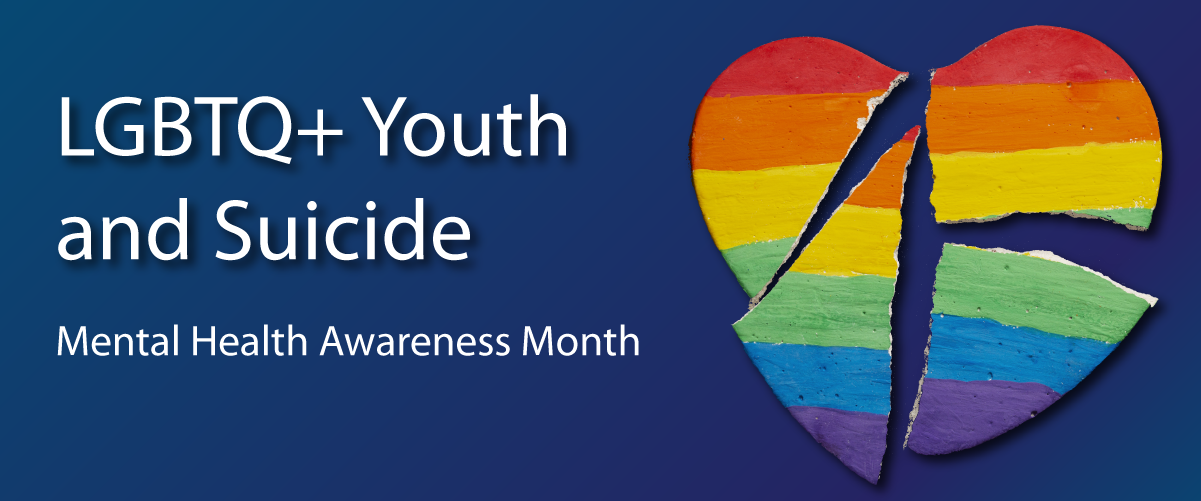
By Alexandrea Rebar LICSW, CMHS, MHP
May is Mental Health Awareness Month, and this May, it is more important than ever to bring awareness to suicidality in LGBTQ+ youth. LGBTQ+ youth often experience psychological harm by loved ones, strangers and others close to them at the expense of their own mental health. This is likely because the important people in their lives do not accept, respect or support them and refuse to use preferred names and pronouns. LGBTQ+ youth who live in a community that is accepting of LGBTQ+ people reported much lower rates of attempting suicide than those who do not, according to The Trevor Project. LGBTQ+ youth are four times more likely to attempt suicide than their peers (Johns et al., 2019; Johns et al., 2020). The Trevor Project’s 2023 U.S. National Survey on the Mental Health of LGBTQ Young People found that 41% of LGBTQ+ young people seriously considered attempting suicide in the past year, including roughly half of transgender and non-binary youth.
LGBTQ+ Youth and Mental Health
LGBTQ+ youth have faced disparities that have impacted their mental health long before the Stonewall Riots of 1969. These include and are not limited to minority stress, rejection and lack of social supports and affirming spaces, difficulties with access and availability to gender-affirming physical health and mental health care, physical harm and bullying, discrimination and harassment, anti-LGBTQ+ legislation, religious ideals forced upon them by friends and family, and conversion therapy.
Intersectionality plays an important role as well. There are ingrained beliefs within cultures and family systems that mental health is not something shared with others and when LGBTQ+ youth are from a minority group, they can internalize anti-LGBTQ+ and anti-mental health messages and not seek help from the community. When The Trevor Project completed their national survey in 2023, they found LGBTQ+ youth of color reported higher rates of attempting suicide than their white counterparts. (The Trevor Project, 2023). Across race and ethnicity, Native American/Indigenous youth who are Two-Spirited /LGBTQ+ consistently report the highest suicide risk (The Trevor Project, 2024). Understanding how intersectionality and disparities affects LGBTQ+ youth is key in being able to provide support, advocate for them, and helping to decrease the rate of suicide attempts for LGBTQ+ youth.
Uplifting LGBTQ+ Youth-Support, Advocacy, and Being an Ally
Ways to decrease suicidal ideation and death by suicide in LGBTQ+ youth can be done through uplifting them. The most important ways to do this are through support, advocacy and being an ally. You can support LGBTQ+ youth by listening to their feelings and concerns and making them feel heard, supporting and loving them unconditionally, and using their preferred name and pronouns. You can donate and/or volunteer at The Human Rights Campaign and The Trevor Project, just to name a few on the national level. Here in Washington, there are LGBTQ+ youth spaces you can donate to or volunteer your time at: Oasis Youth Center in Tacoma, Lambert House in Seattle, and Stonewall Youth in Olympia. Other local youth centers can be found at www.glsenwashington.org/partnerships. Supporting local, national and global LGBTQ+ small businesses helps with access to physical and mental health care, increased well-being, and increased income for LGBTQ+ folks.
Advocating is another way to uplift and empower LGBTQ+ youth. Going to Olympia, posting comments on bills that may be passed, or talking at town halls has an immense impact on the ability for bills that positively influence LGBTQ+ youth and adults. Calling Washington State officials or writing letters to prevent anti-LGBTQ+ legislation from being passed and encouraging them to continue passing bills that protect the LGBTQ+ community relating to access to mental health and gender-affirming care, changing gender markers on state and government documents, and increases in funding for shelters and youth centers for LGBTQ+ youth are essential for the health and well-being of those in the community.
Being an ally is more than just being there for LGBTQ+ youth. It requires a significant amount of effort and calling in people in the community, loved ones, coworkers, etc., who are not respectful, understanding, accepting or supportive of anyone in the LGBTQ+ community. Being an ally requires educating yourself, learning what each letter in LGBTQIA+ means, common definitions used, the history of the LGBTQ+ movement before the Stonewall Riots, keeping crisis lines specifically for LGBTQ+ youth and the trans resource guide for your county on hand, and not expecting folks in the community to educate you. To find out more on being an LGBTQ+ ally, please check out these resources:
Human Rights Campaign Foundation: Being an LGBTQ+ Ally King County Trans Resource & Referral Guide